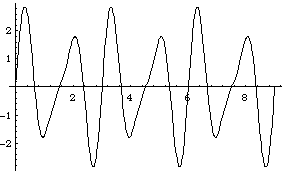
| 4. (a) S1(.75)=-1, S1(1.5)=0, S1(2.25)=1, S1(3)=0, S1(3.75)=-1, S1(4.5)=0 |
| (b) At all times indicated, S2(t)=0. |
| (c) From (b) we see at the times indicated, S3(t)=S1(t). |
| (d) The plot below shows S3(t) repeats after t increases by 3, so the frequency of S3(t) is 1/3 Hz. Comparing this with (c), we see some care must be exercised in making inferences: unluckily chosen sampling times can give misleading results. |

|
Return to Exercises